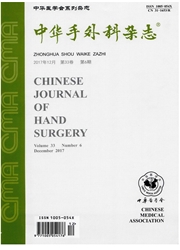

 中文摘要:
中文摘要:
目的探讨荧光染料PKH-26在构建组织工程周围神经中作为细胞示踪剂的可行性。方法取新西兰大白兔颈背部脂肪组织分离,培养脂肪干细胞(adiposederivedstemcells,ADSCs),用荧光染料PKH-26进行标记,荧光显微镜观察并采用流式细胞仪检测标记率,MTT法检测细胞增殖活性;体外成骨、成脂及成软骨诱导鉴定细胞的多向分化潜能;将PKH-26标记后的ADSCs采用显微注射法植入改良脱细胞神经支架上构建组织工程化周围神经,体外培养1、2、4周后采用电镜及冰冻切片技术,观察细胞在支架内存活、迁移的情况。结果PKH-26能有效标记ADSCs,标记率为95.12%;M3T法检测及成骨、成脂、成软骨诱导结果显示,PKH-26标记对细胞增殖及多向分化潜能没有影响;在体外培养环境下,ADSCs能在脱细胞神经支架上生长并沿着支架迁移,荧光可存留4周以上。结论PKH-26标记ADSCs可作为一种体外构建组织工程化周围神经短期示踪的有效手段。
 英文摘要:
英文摘要:
Objective To assess the feasibility of using fluorescent dye PKH-26 as a cell tracer in the construction of tissue engineered peripheral nerve. Methods Primary adipose derived stem cells (ADSCs) were isolated by elmyrnatic digestion of adipose tissue from the back of the neck of New Zealand white rabbits. The ADSCs of passage 3 were labeled with PKtt-26 and were observed under fluorescence microscope. Flow cytometry was used to detect the percentage of the labeled cells. The cellular vitality was detected by M'IT assay, while the differentiation abilities of the cells were tested by in vitro adipegenic, osteogenic and chondrogenic differentiation. Then the labeled cells were micro-injected into the modified acellular nerve scaffolds to build the tissue engineered nerve. After being cultured in vitro for 1, 2 and 4 weeks, scanning electron microscopy and frozen sections were used to observe the sm'vival and migration of the cells in the scaffold. Results PKIt-26 dye was effective for labeling ADSCs with a 95.12% labeling rate. Cell vitality and differentiation abilities were not affected by the PKH-26 dye. Furthermore, ADSCs could survive and migrate in the nerve scaffold. Tile fluorescence could last for at least 4 weeks. Conclusion PKH-26 can be used as ADSCs label for the construction of tissue engineered peripheral nerve and for short-term cell tracing.
 同期刊论文项目
同期刊论文项目
 同项目期刊论文
同项目期刊论文
 Comparison of Decellularization Protocols for Preparing a Decellularized Porcine Annulus Fibrosus Sc
Comparison of Decellularization Protocols for Preparing a Decellularized Porcine Annulus Fibrosus Sc Novel cartilage-derived biomimetic scaffold for human nucleus pulpous regeneration: a promising ther
Novel cartilage-derived biomimetic scaffold for human nucleus pulpous regeneration: a promising ther 期刊信息
期刊信息
